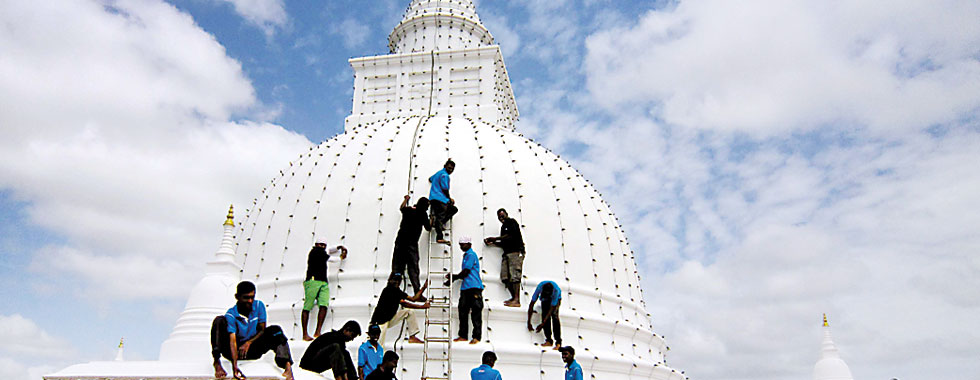The two siblings who changed the course of history
Poson is the time when we talk about the significance of Sangamitta Theri and Ven. Mihindu who were instrumental in introducing and consolidating Buddhism in Sri Lanka. We meet them at this time of the year when Poson is celebrated especially in the Anuradhapura District.

Preparations underway for the Aloka Pooja at Thanthirimale. Pic by Athula Devapriya
When we study the history of Buddhism, we realise that the greatest blessing was the conversion of the Indian king Asoka to Buddhism. Afterwards at the Council he convened under the advice and chairmanship of Moggaliputta Tissa Thera, Asoka decided to spread Buddhism to other states and countries in a systematic way. Better known as Dharmasoka in India, he knew that Buddhism could be established in Lanka as his friend Tissa or Devanampiyatissa was the king here.
King Asoka had already started spreading Buddhism in neighbouring countries and in the remote Indian Provinces by sending special envoys who were close to him. For Sri Lanka he selected Mahinda, his firstborn who had become a monk in his early 20s. The name Mahinda actually means conqueror of the world.
Ven. Mahinda had already attained a very high state in his quest for perfection, he had reached the Arahat state and his father felt that his son was the ideal person to go to Sri Lanka and spread the great teachings of Lord Buddha. Of course Lord Buddha, had visited Sri Lanka on three occasions very much earlier, but these visits were for special reasons. Arahat Mahinda’s trip to Sri Lanka was somewhat delayed as he had to wait till the death of the ageing King Mutasiva. As far as the calculations go it was on the memorable Poson full moon day in the month Jattha (June), in BC 306, 237 years after the parinibbana of the Lord Buddha, that the Arahat Mahinda, met King Devanampiyatissa, atop the Mihintale rock which was then known as Missaka-pabbata. With this meeting things changed for the better for our country.
We know that the local king, Tissa, was not expecting this special emissary from India. It was a festival time in his kingdom and he was involved in his preferred pastime, deer hunting. Most of his countrymen worshipped Yakkas, devas on trees, rocks etc. Arahat Mahinda appearing just when Tissa was chasing behind a deer, took the King by surprise. He preached to the king the famous sermon Chullahaththi padopama sutta and converted him and his followers to Buddhism.
With the blessings and the royal protection of the king Tissa, Arahat Mahinda soon spread the teachings of Lord Buddha and established Buddhism on a firm footing here. The succeeding years were marked by increasing activity in religious affairs in most parts of the island. Buddhism spread to every town, village and all corners with the help of Ven Mahinda’s group of monks. A large number of viharas, chetiyas and other religious places soon began to dot the island contributing to the growth of religious sentiments.
According to some historians Ven. Mahinda had arrived here when he was 32 years old. Apart from the fact that he did very much for the founding of Buddhism and the establishment of the Buddha Sasana in Sri Lanka, he also brought about a real socio religious awakening and was instrumental in bringing cultural and economic progress with irrigation and other construction programmes. Arahat Mahinda lived for 80 years, 60 out of them as a bhikkhu. He passed away in BC 259.
The coming of theri Sangamitta (meaning ‘friend of Sanga’) to Sri Lanka was entirely at the request of the King Devanampiyatissa, as Queen Anula desired to be ordained along with her women companions as Buddhist nuns. Arahat Mahinda had already converted many to Buddhism but the ordination of women as Buddhist nuns had to be performed by a Buddhist nun. So Arahat Mahinda informed King Devanampiyatissa to send a request to his father in India and arrange for this.
King Asoka was a little hesitant at first, as Sangamitta was his favourite child and ordained only at the tender age of 18, but at her insistence allowed her to undertake the journey to Sri Lanka. She had just passed 32 years at the time, like her brother, and something told him that he would not see her again.
Theri Sangamitta did not come empty handed. She along with her large retinue of Buddhist nuns brought along a sapling of the great Sri Maha Bodhi via Dambakola Patuna, close to what we call Mathagal. King Devanampiyatissa is said to have accepted the Sacred sapling from her and with a large retinue brought it to Anuradhapura after a stop at Thivakka Bamunugama (presently Thanthirimale). At Thanthirimale this event is now annually celebrated especially during the Unduwap Poya in December.
History records that Theri Sangamitta died at the age of 79 when Uttiya was the king, and was cremated close to Thuparama at a spot selected by her earlier. It is said that the King erected a stupa over her ashes.
At a time when our ancestors were worshipping trees and rocks these two venerable siblings dedicated their lives for our betterment. When we examine some of the ancient caves at Thanthirimale we see prior to their arrival how people lived with ancient implements and with very limited housing. After the arrival of Arahat Mahinda we see the development of our agriculture, industry and building construction. Irrigation developed with the kings taking the initiative to harness rivers. The whole country took a leap forward due to their influence.
The first Poson brought about a change in the beliefs, the way people behaved and instilled discipline into our ancestors. Its message is more relevant today than at any time, because we have deviated so much and so very far from it.
Follow @timesonlinelk


